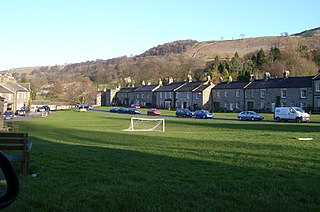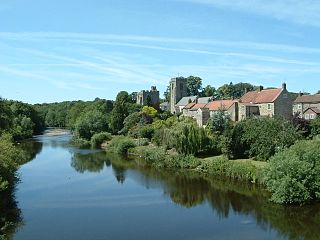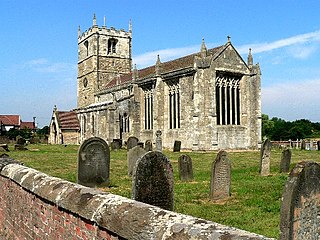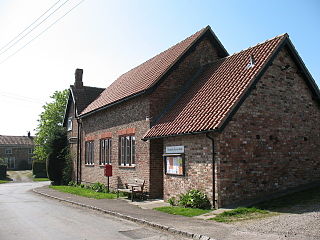
Burton Agnes is a village and civil parish in the East Riding of Yorkshire, England. It is situated on the A614 road midway between Driffield and Bridlington.

Bishop Burton is a village and civil parish in the East Riding of Yorkshire, England. It lies on the A1079 road approximately three miles (5 km) to the west of the market town of Beverley.

Sewerby is a village in the East Riding of Yorkshire, England approximately 1 mile (1.6 km) north-east of Bridlington on the North Sea coast. The village is on Bridlington Bay and is the only south-facing resort in the East Riding of Yorkshire.

Hovingham Hall is a country house built in the Palladian style in the village of Hovingham, North Yorkshire, England. It has been the seat of the Worsley family and the childhood home of the Duchess of Kent. It was built in the 18th century on a site the Worsleys have occupied since the 16th century.

Sheriff Hutton is a village and civil parish in North Yorkshire, England. It lies about 10 miles (16 km) north by north-east of York.

Weeting Castle is a ruined, medieval manor house near the village of Weeting in Norfolk, England. It was built around 1180 by Hugh de Plais, and comprised a three-storey tower, a substantial hall, and a service block, with a separate kitchen positioned near the house. A moat was later dug around the site in the 13th century. The house was not fortified, although it drew on architectural features typically found in castles of the period, and instead formed a very large, high-status domestic dwelling. It was probably intended to resemble the hall at Castle Acre Castle, owned by Hugh's feudal lord, Hamelin de Warenne.

West Burton is a village in Bishopdale, a side valley of Wensleydale, in the Yorkshire Dales, North Yorkshire, England. It lies 6.2 miles (10 km) south-west of Leyburn and 22.3 miles (35.9 km) west of the county town of Northallerton. It is the largest settlement in the civil parish of Burton-cum-Walden.

West Tanfield is a village and civil parish in the Hambleton district of North Yorkshire, England. The village is situated approximately six miles north of Ripon on the A6108, which goes from Ripon to Masham and Wensleydale. The parish includes the hamlets of Nosterfield, Thornborough and Binsoe.

Burton Agnes Hall is an Elizabethan manor house in the village of Burton Agnes, near Driffield in the East Riding of Yorkshire, England. It was built by Sir Henry Griffith in 1601–10 to designs attributed to Robert Smythson. The older Norman Burton Agnes Manor House, originally built in 1173, still stands on an adjacent site; both buildings are now Grade I listed buildings.
Weston is a village and civil parish in the former Harrogate district of North Yorkshire, England. The village is 1.2 miles (2 km) north–west of Otley and near the River Wharfe which forms the boundary between North and West Yorkshire. The name is from Old English and means western enclosure, farmstead or village.
Sir Matthew Boynton, 1st Baronet was an English landowner and politician who sat in the House of Commons in two parliaments between 1621 and 1647. He supported the Parliamentary cause in the English Civil War.

Kirklington is a village in the English county of North Yorkshire close to the A1(M) motorway. Kirklington forms the major part of the civil parish of Kirklington-cum-Upsland.

Markenfield Hall is an early 14th-century moated manor house about 3 miles (5 km) south of Ripon, North Yorkshire, England. It is in the civil parish of Markenfield Hall.
Bossall is a hamlet in North Yorkshire, England with fewer than 100 residents.

Skipwith is a village and civil parish about 4 miles (6.4 km) north-east of Selby and 10 miles (16 km) south-east of York in North Yorkshire, England. It was historically in the East Riding of Yorkshire. After the 1974 local government reorganisation Skipwith was in the Selby District of the shire county of North Yorkshire. In 2023 the district was abolished and North Yorkshire became a unitary authority.

The Boynton baronetcy, of Barmston in the County of York, was a title in the Baronetage of England. It was created on 15 May 1618 for Matthew Boynton, son of Sir Francis Boynton of Barmston Hall, in the East Riding of Yorkshire. The Boyntons came to Barmston following the marriage of heiress Margaret de la See to Sir Henry Barmston in the 15th century. The first Baronet married Francis Griffith, heiress of an estate at Burton Agnes including Burton Agnes Hall and Burton Agnes Manor House which the second Baronet inherited in 1647. The fifth and sixth Baronets both served as High Sheriff of Yorkshire, in 1750 and 1771 respectively. The eleventh Baronet died without male issue and the Baronetcy passed to his cousin. His estates however passed to his daughter Cicely whose husband Thomas Lamplugh Wickham changed his name on marriage to Wickham-Boynton, and later (1989) to Cunliffe-Lister relations descended from Mary Constance Boynton, wife of the 1st Earl of Swinton. The title became extinct on the death of the thirteenth Baronet in 1966.

Thirkleby High and Low with Osgodby is a civil parish in North Yorkshire, England. The parish includes the villages of Great Thirkleby and Little Thirkleby and the scattered hamlet of Osgodby. The similarly named medieval settlement of Thirkleby Manor is around 30 miles north, in the parish of Kirby Grindalythe, Ryedale District. The population of the civil parish taken at the 2011 Census was 266.

Great Mitton is a village and a civil parish in the Ribble Valley, Lancashire, England. It is separated from the civil parish of Little Mitton by the River Ribble, both lie about three miles from the town of Clitheroe. The combined population of both civil parishes at the 2011 census was 266. In total, Great and Little Mitton cover less than 2000 acres of the Forest of Bowland, making it the smallest township in the Forest. Historically, the village is part of the West Riding of Yorkshire, but was transferred to Lancashire for administrative purposes on 1 April 1974, under the provisions of the Local Government Act 1972.

Whorlton Castle is a ruined medieval castle situated near the abandoned village of Whorlton in North Yorkshire, England. It was established in the early 12th century as a Norman motte-and-bailey associated with the nearby settlement. The castle is an unusual example of a motte-and-bailey that remained in use throughout the Middle Ages and into the early modern period.

There have been two baronetcies created for persons with the surname Griffith, one in the Baronetage of England and one in the Baronetage of the United Kingdom. Both creations are extinct.
















